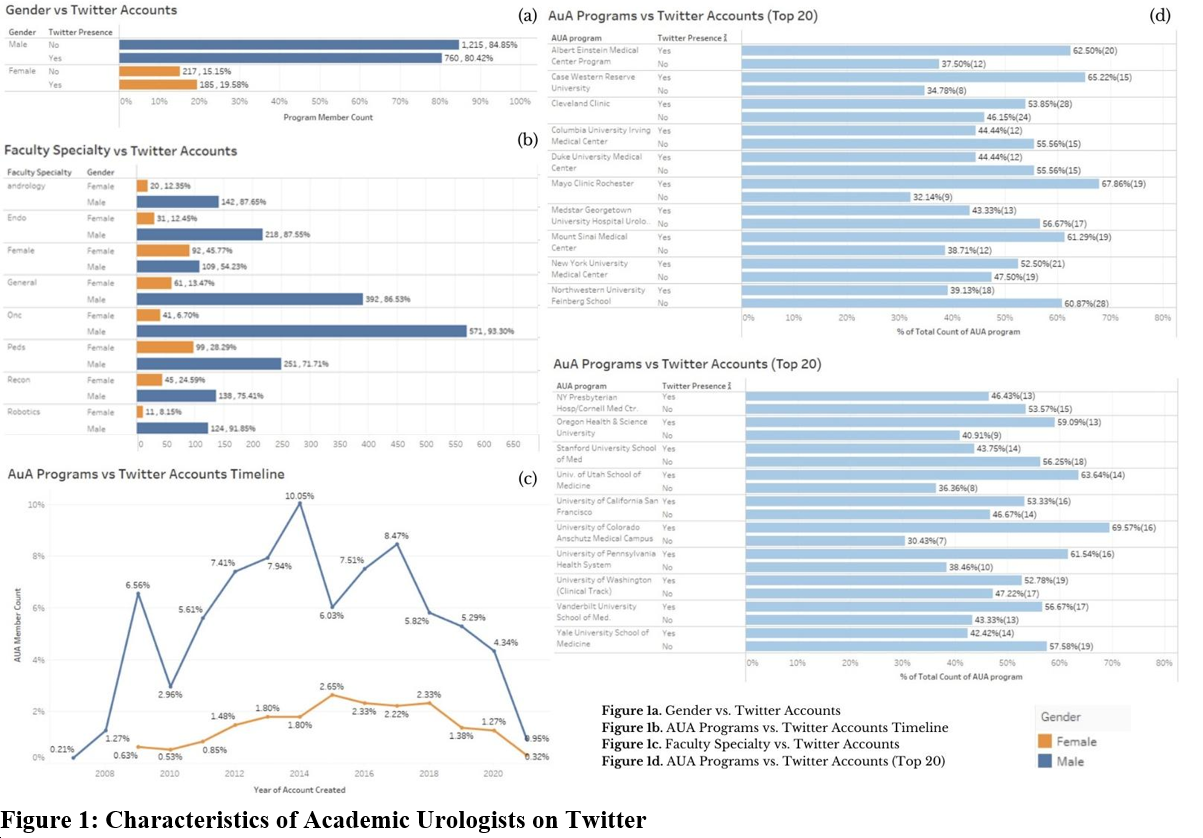Back
Poster, Podium & Video Sessions
Moderated Poster
MP19: Education Research II
MP19-07: Characterizing the Use of Twitter Amongst Academic Urologists
Saturday, May 14, 2022
7:00 AM – 8:15 AM
Location: Room 228
Alberto Castro Bigalli*, Philadelphia, PA, Clara Sun, Ilaha Isali, Cleveland, OH, Andrew Gianakopoulos, Justin Dubin, Chicago, IL, Seyed Behzad Jazayeri, Jacksonville, FL, Mohit Sindhani, New Delhi, India, Laura Bukavina, Philadelphia, PA
- AC
Poster Presenter(s)
Introduction: The dramatic reduction of clinical and research activities within medicine during COVID-19, coupled with virtual electives and conferences, have all posed important implications within academics. Given the heavy reliance on virtual interaction during the pandemic and the active role that social media (SoMe) has, our study aims to characterize the state of SoMe use among current academic urology faculty.
Methods: We identified residency programs utilizing the American Urological Association (AUA) website. All MD/DO faculty information including gender, program location, and subspecialty training was recorded. After the designation of all faculty and their Twitter handles, Twitter Development API was set up with required authorizations and tokens. Python and R were used as the supporting language and setup using Anaconda Navigator.
Results: We identified 143 residency programs with a total of 2,377 faculty (1,975 males and 402 females). Among all faculty, 945 (39.75%) had registered Twitter accounts with the majority being male [760 (80.40%) vs 185 (19.60%)] (Figure 1a). Proportionately, female urologists were more likely to have a registered Twitter account (Figure 1a). Differences among specialty and SoMe use were also evident, with oncology (48%) and endourology (47.24%) among male faculty representing the highest registered user accounts (Figure 1b). When assessing registered accounts by gender across all faculty, there was no notable change during COVID (2019-2020), with peak for male faculty in 2014 (10.05% of all accounts registered) and peak for female faculty in 2015 (Figure 1c). The top five hashtags by occurrence were #prostatecancer, #urology, #bladdercancer, #covid19, and #aua19 among males, female faculty extending #sexmed as an additional common hashtag. When assessing faculty representation on Twitter, The University of Colorado (69.57%), Mayo Clinic Rochester (67.86%), and Case Western Reserve (65.22%) had the most represented faculty on SoMe proportional to the size of their program (Figure 1d).
Conclusions: There is a steady increase in Twitter representation among academic urology, largely unaffected by COVID. While the majority of Twitter representation is largely skewed toward male faculty, there has been a steady increase in female faculty representation across all subspecialties over the last 16 years.
Source of Funding: None

Methods: We identified residency programs utilizing the American Urological Association (AUA) website. All MD/DO faculty information including gender, program location, and subspecialty training was recorded. After the designation of all faculty and their Twitter handles, Twitter Development API was set up with required authorizations and tokens. Python and R were used as the supporting language and setup using Anaconda Navigator.
Results: We identified 143 residency programs with a total of 2,377 faculty (1,975 males and 402 females). Among all faculty, 945 (39.75%) had registered Twitter accounts with the majority being male [760 (80.40%) vs 185 (19.60%)] (Figure 1a). Proportionately, female urologists were more likely to have a registered Twitter account (Figure 1a). Differences among specialty and SoMe use were also evident, with oncology (48%) and endourology (47.24%) among male faculty representing the highest registered user accounts (Figure 1b). When assessing registered accounts by gender across all faculty, there was no notable change during COVID (2019-2020), with peak for male faculty in 2014 (10.05% of all accounts registered) and peak for female faculty in 2015 (Figure 1c). The top five hashtags by occurrence were #prostatecancer, #urology, #bladdercancer, #covid19, and #aua19 among males, female faculty extending #sexmed as an additional common hashtag. When assessing faculty representation on Twitter, The University of Colorado (69.57%), Mayo Clinic Rochester (67.86%), and Case Western Reserve (65.22%) had the most represented faculty on SoMe proportional to the size of their program (Figure 1d).
Conclusions: There is a steady increase in Twitter representation among academic urology, largely unaffected by COVID. While the majority of Twitter representation is largely skewed toward male faculty, there has been a steady increase in female faculty representation across all subspecialties over the last 16 years.
Source of Funding: None

.jpg)
.jpg)